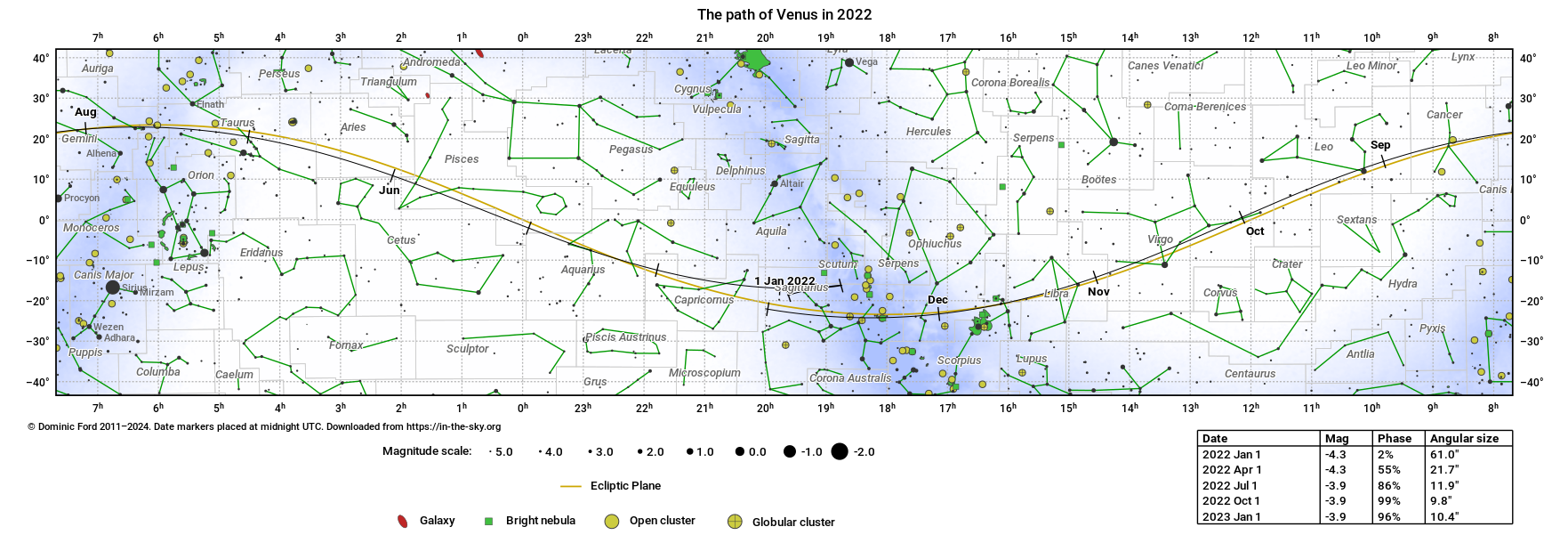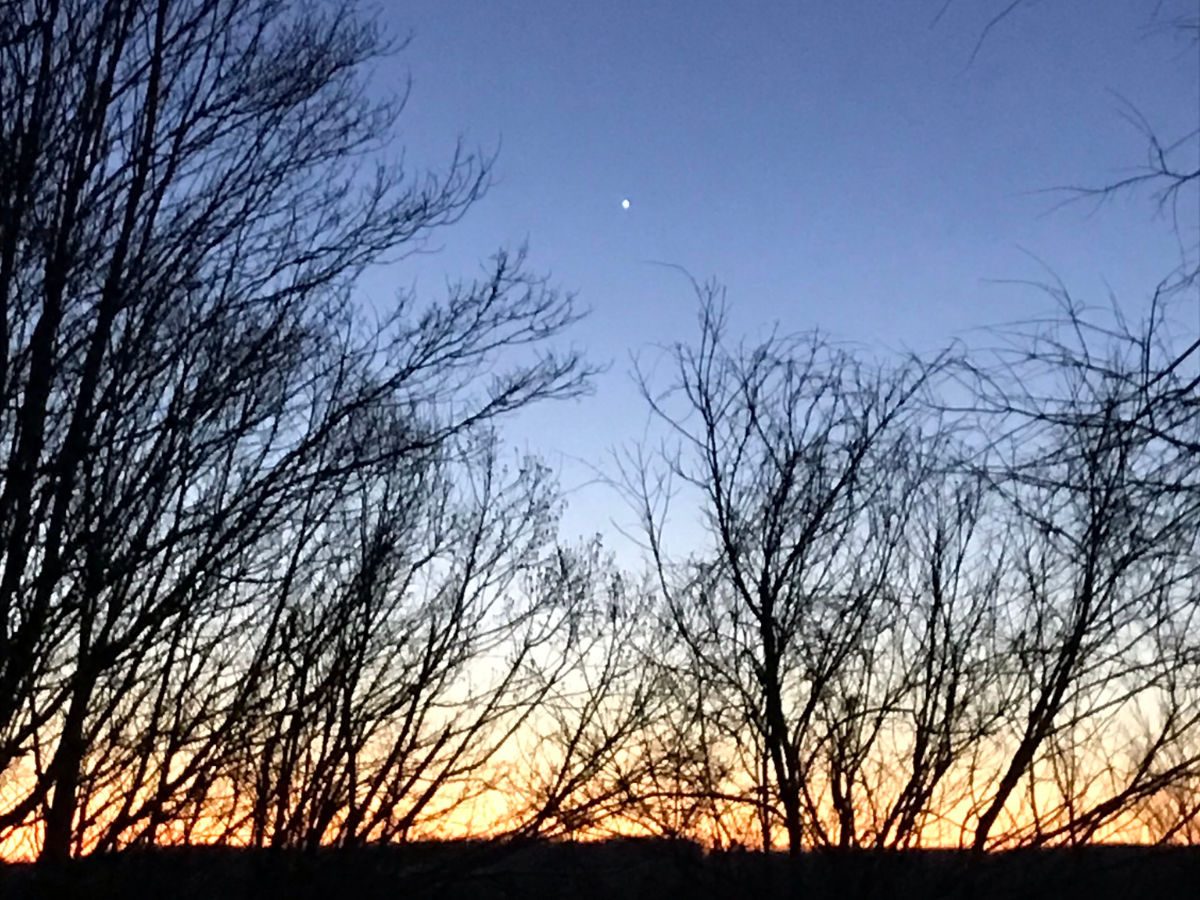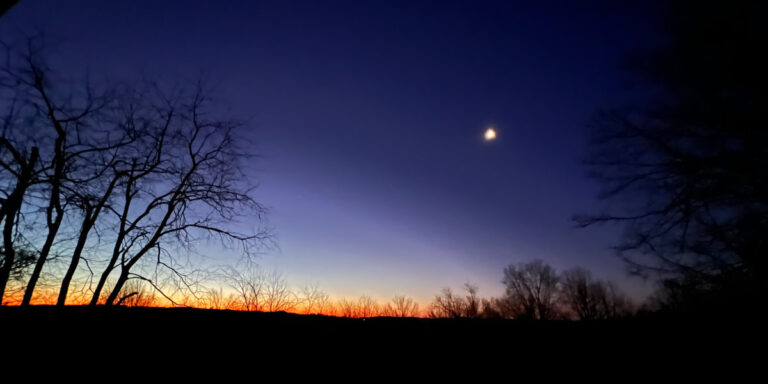Photo by Katy Morikawa
Audio
Or find the audio wherever you get your podcasts.
The Morning Star has risen! Venus will be our companion in the morning sky this winter through spring and summer into early fall until it disappears into the sun’s glow on September 14, 2022. Now, while Venus is moving retrograde, preparing to move direct on January 29, 2022, this is a wonderful time to reflect on Venus, both the glimmering planet and the archetypes surrounding it.
Venus is now easily visible in the east, a glimmering diamond in the predawn glow. Here in North America, sunrise in January is around 7:30 AM, so it’s a good time of year to see the Morning Star, especially if you’re not a morning person! (Use your Weather app to find sunrise in your location). If you can get out an hour before sunrise (for us at 6:30 AM), Venus is high enough in the east that most people with a view that direction should be able to see it. It is very bright! HUGE and beautiful as dawn is beginning to throw a line of color along the horizon. As Venus rises with the sun, and sunrise approaches, it shrinks and fades until it disappears in the bright sky.
This morning, Venus was still a faint glimmer for about 15 minutes after the orange ball of the sun climbed up over the lip of the Earth to cast its beautiful golden light upon the landscape. One nice thing about getting up to watch all of this is you get your dose of morning sun. Andrew Huberman opened my eyes (pun?!) to the health benefits of low angle sunlight in the morning: when drunk in directly and not through window glass, it resets our internal clocks, improves mood, health, sleep, and more. I feel like it’s helped get me out of my funk and I feel much more resilient and optimistic these days! (Don’t look directly at the sun, and don’t do this if you have macular degeneration).

Here’s the link to that podcast episode. The embed code doesn’t seem to want to tee it up to that point in the show, so you’ll want to go to 1:20:07 for that segment.
Right now (January 26, 2022), the Moon is high in the sky to the right (or left if you’re in the southern hemisphere) and just past it’s last quarter phase, waning into a crescent. Over the next few days, if you go out an hour or so before dawn, you’ll find the Moon farther and farther East and shrinking down to an increasingly a smaller cresecent as the balsamic moon dispenses its wisdom from the past month.
Then on January 29 and 30th, you can see the Star and Crescent together in the East (the best view will be the morning of the 30th most places in the Northern Hemisphere). If you miss the week-long approach of the moon from its highpoint in the predawn sky, as well as the dramatic alignment of the Moon and Venus, you can catch it next month, and every month for the next eight months!
Here is a list of the dates for the 2022-2023 Venus Cycle. More soon in a coming post about how to think about these dates from a mythical and astrological perspective.
Before I share some of the mythology and meanings around Venus, I’d like to create some space around it, to honor Venus as itself–both as a nearby planet and an expression of Mystery. I do this with the hope that it might transmit something directly to you, and that you might make your own intimate and personal relationship with it. So, for that reason, I encourage you to take this roll call of mythological associations with a small (or large) grain of salt.
Wikipedia’s article, Venus in culture, says this: “Venus, as one of the brightest objects in the sky, has been known since prehistoric times and has been a major fixture in human culture for as long as records have existed. As such, it has a prominent position in human culture, religion, and myth. It has been made sacred to gods of many cultures, and has been a prime inspiration for writers and poets as the morning star and evening star.”
Venus in Mythology and Archetype
- The Morning Star
- Bringer of the Dawn
- Phosphoros “Bringer of the Light,” Heosphorus “Dawn-Bringer” (Ancient Greek)
- Lucifer (Morning Star, son of Aurora, the Dawn); and Vesper or Hesperus (Evening Star, another son of Aurora) (classical mythology) associated with the goddess Venus but not identical
- The Son of God, Epiphany (Christian)
- Earandil – (Middle Earth) the great half-Elven lord who sails across the sky with the brilliant Silmaril upon his brow and sees the Undying Lands
- The Goddess – Inanna (Sumeria), Ishtar (Akkadian, Babylonian), Astarte (the Levant – Caananite, Phoenecian, Iberian), Annahita (Persian), Zohra (Islamic), Aphrodite (Hellenistic Greek), Venus (Roman), Branwen (Welsh), Cliodhna (Irish), “The Great Star” Chac ek (Maya, master astronomers who tracked the Venus cycles).
- The Divine Feminine
- The Anima Psyche
- The Anima Mundi (the World Soul)
When thinking about all the ways that cultures have described and imagined Venus, I think it’s important to remember that all of life has been evolving for billions of years under the celestial rhythms of sun, moon, stars, and planets. Venus and its regular appearances in the dawn and evening skies, meeting the moon every month for seven or eight months, disappearing for a period of time in the glare of the sun–certainly kept us company during the eons since life emerged from the slime in the ancient tide pools. It was present as the DNA climbed up the tree of life and branched out to create the vast diversity of life on earth. Did you know all living things on earth share the same DNA and that the differences between us and an amoeba is less than you might think? That blows my mind a little and makes real the notion that we are all related and connected. However it happened, there are innumerable myths, fairy tales, and stories which echo both the patterns of the movements of the sun, moon, and planets, as well as an archetypal coherence to the collection of meanings surrounding each of them. Venus is no exception.
The Principles of Venus in Astrology
- Beauty and love
- Harmony and refinement
- Wealth and culture
- The feminine and female characters
- Pleasure of the senses, epicurian delights
- Passion and sensuality
- Fertility, fecundity, creativity
- Resources and possessions
- Embodiment / the body / matter
- The Earth and nature and living things
- Suchness / one’s nature
- The personal anima by projection or internalization
- The feminine principle of magnetism, receptivity, and presence, which is most powerfully activated through love
- The unity of the soul and the body (the teachings of animism get us here)
- The consciousness of all living things, and the Living Earth
- The relationship between one’s own soul essence and the things one loves and owns (this is the power of tidying up to clarify the life and emotions, the parable of the abandoned house)
- The immanence in all things, living and non, of spirit or soul
- The power of love to command matter
My next astrology post will be about the Venus Cycle, focusing on the Morning Star phase, which begins on January 29, 2022 and goes to September 14, 2022. Meanwhile, here’s a cool graphical map for finding Venus in the sky in 2022. Link below for generating your own maps, both interactive maps and more detailed downloadable maps at In-the-Sky.org.

I invite you to relate directly with Venus and do your own discovery process. You could do an Imaginal Journey with Nature along the lines of the process I shared in Episode 6: An Imaginal Journey with Nature in 7 Easy Steps.
Links
Starshine Astrology Planner https://katymorikawa.com/starshine-astrology/
Astrology Resources https://katymorikawa.com/astrology-resources/
Venus in culture. In Wikipedia, The Free Encyclopedia. Retrieved 16:32, January 26, 2022, from https://en.wikipedia.org/w/index.php?title=Venus_in_culture&oldid=1066845266
Planets in astrology. In Wikipedia, The Free Encyclopedia. Retrieved 16:33, January 26, 2022, from https://en.wikipedia.org/w/index.php?title=Planets_in_astrology&oldid=1066344802
Shamanic Astrology https://shamanicastrology.com/
In-the-Sky.org charts for finding Venus (downloadable or interactive) https://in-the-sky.org/findercharts2.php?id=P2






This morning I went out to watch the waning crescent moon suspended with bright Venus in the predawn sky. It looked like a fairy tale moon and star, the sky a deep periwinkle blue. Using the Imaginal process I shared in Episode 6, I opened to Venus and received two things: 1. A way to stand to connect with Venus – squaring up to face it and aligning your forehead with the Star, like Earandil with the Silmaril on his brow, holding that image in your mind when you close your eyes; and 2. If you hold your hand out at arm’s length, make a circle with your forefinger and thumb and can capture two celestial objects inside that circle, you have a true conjunction alignment. This morning, the moon and Venus just barely fit. They were 10 degrees apart, the classical orb for a conjunction. Neat tip. Venus stationed direct this morning at 3:45 am (EDT), and makes its exact conjunction alignment with the moon at 10:08 pm tonight at 11°05′ Capricorn. You can see the moon and Venus together again tomorrow morning in the hours before dawn – try 6:30 am for a nice time to see Venus very bright with the crescent moon.
52mReply
Venus: One day I heard that Venus was very close to the moon, and I saw it, in full daylight, using the moon to find it.
Not hard to see in the day, if one can just find it!
Jim
Wow! That is amazing. I don’t think I’ve heard that story before. It is true that clear unclouded daylight is sometimes deeper/darker than other days, so it would make sense one might be able to see a bright planet during the day under the right conditions. Thanks for sharing.